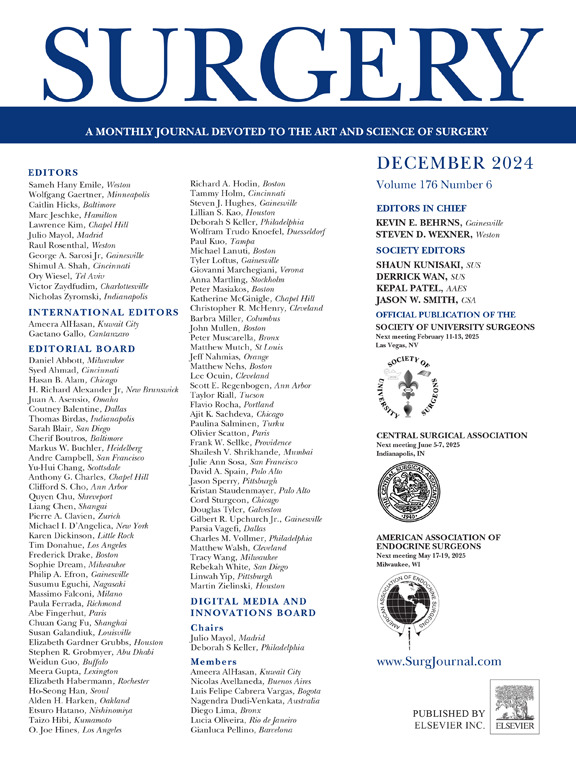Comprehensive comparison of technical performance, surgical outcomes, and oncologic prognosis between remnant gastric cancer and primary upper-third gastric cancer in the era of minimally invasive surgery: A pooled analysis of 3 prospective trials
IF 3.2
2区 医学
Q1 SURGERY
引用次数: 0
Abstract
Background and Objective
To compare the technical performances and short- and long-term outcomes of laparoscopic total gastrectomy for remnant gastric cancer and primary upper gastric cancer.
Methods
This prospective study (FUGES-004 study) enrolled 50 remnant gastric cancer patients who underwent laparoscopic total gastrectomy at Fujian Medical University Union Hospital between June 2016 and June 2020 (ClinicalTrials.gov identifier: NCT02792881). Propensity score matching (1:2) was used to select upper gastric cancer patients who underwent laparoscopic total gastrectomy in the FUGES-001 and FUGES-002 studies. Technical performance was assessed using the General Error Reporting Tool, Objective Structured Assessment of Technical Skills (OSATS), and Intraoperative Complication Classification.
Results
After matching, 46 remnant gastric cancer and 92 upper gastric cancer patients were included in the final analysis. Abdominal adhesions in the epigastrium, central abdomen, and bowel-to-bowel regions were more severe in the remnant gastric cancer group (P < .001). The remnant gastric cancer group had more technical errors and intraoperative adverse events (especially grade I bleeding) during surgery (P < .05). However, the Objective Structured Assessment of Technical Skills scores were comparable between the remnant gastric cancer and upper gastric cancer groups (30.8 vs 31.0, P = .799). Although the severe postoperative complication rates were similar between the 2 groups (P = .333), the postoperative complication rate was significantly higher in the remnant gastric cancer group (28.3% vs 7.6%, P = .001). Additionally, the long-term oncologic outcomes (including 3-year disease-free survival, overall survival, and recurrence pattern) were comparable between the remnant gastric cancer and upper gastric cancer groups (log-rank P > .05).
Conclusions
Although the long-term oncologic outcomes were comparable between the groups, the remnant gastric cancer group had more intraoperative errors and adverse events and higher postoperative complication rates than the upper gastric cancer group. For complex remnant gastric cancer cases, laparoscopic total gastrectomy may serve as an effective therapeutic option. However, experienced surgeons at high-volume centers should exercise caution when performing laparoscopic total gastrectomy and implement more rigorous perioperative management strategies.

微创手术时代残胃癌与原发性上三分之一胃癌技术性能、手术疗效及肿瘤预后的综合比较:3项前瞻性试验的汇总分析
背景与目的比较腹腔镜下残胃癌与原发性上胃癌全胃切除术的技术性能及近期和远期疗效。方法本前瞻性研究(FUGES-004研究)纳入2016年6月至2020年6月在福建医科大学协和医院行腹腔镜全胃切除术的50例残胃癌患者(ClinicalTrials.gov识别符:NCT02792881)。在FUGES-001和FUGES-002研究中,采用倾向评分匹配(1:2)选择行腹腔镜全胃切除术的上胃癌患者。使用通用错误报告工具、客观结构化技术技能评估(OSATS)和术中并发症分类评估技术性能。结果匹配后,最终纳入46例残胃癌和92例上胃癌患者。残胃癌组上腹部、中腹部和肠间粘连更为严重(P <;措施)。残胃癌组术中技术错误和术中不良事件(尤其是I级出血)较多(P <;. 05)。然而,残胃癌组和上胃癌组的客观结构化技术技能评估得分具有可比性(30.8 vs 31.0, P = .799)。两组术后严重并发症发生率相近(P = 0.333),但残胃癌组术后并发症发生率明显高于残胃癌组(28.3% vs 7.6%, P = .001)。此外,残胃癌组和上胃癌组的长期肿瘤预后(包括3年无病生存期、总生存期和复发模式)具有可比性(log-rank P >;. 05)。结论虽然两组间长期肿瘤预后具有可比性,但残胃癌组术中错误、不良事件及术后并发症发生率均高于上胃癌组。对于复杂残胃癌病例,腹腔镜全胃切除术可能是一种有效的治疗选择。然而,在大容量中心,经验丰富的外科医生在进行腹腔镜全胃切除术时应谨慎行事,并实施更严格的围手术期管理策略。
本文章由计算机程序翻译,如有差异,请以英文原文为准。
求助全文
约1分钟内获得全文
求助全文
来源期刊

Surgery
医学-外科
CiteScore
5.40
自引率
5.30%
发文量
687
审稿时长
64 days
期刊介绍:
For 66 years, Surgery has published practical, authoritative information about procedures, clinical advances, and major trends shaping general surgery. Each issue features original scientific contributions and clinical reports. Peer-reviewed articles cover topics in oncology, trauma, gastrointestinal, vascular, and transplantation surgery. The journal also publishes papers from the meetings of its sponsoring societies, the Society of University Surgeons, the Central Surgical Association, and the American Association of Endocrine Surgeons.
 求助内容:
求助内容: 应助结果提醒方式:
应助结果提醒方式:


